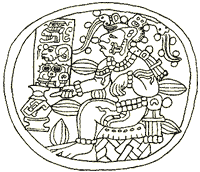|

 Page
Three
Page
Three

|

|
|
|
The
Cacao God of the Classic Maya, from a bowl engraving.
|
|
|
|
By the beginning
of the sixteenth century, the Aztecs had an advanced and powerful
civilization located in what is now central Mexico. Many people
believe that the Aztecs first developed chocolate. However, chocolate
goes back much farther. The ancient Maya, who inhabited what is
now parts of southern Mexico and Central America, certainly consumed
chocolate. In fact, the word "cacao" is Mayan: as early as 500 A.D.,
the Mayans were writing about cacao on their pottery. Some think
chocolate may be even older, dating back to the Olmec civilization
that preceded the Maya.
|

|

|
|
Woodcut
of a "metate," used with an element much like a rolling
pin to grind cacao beans into paste for making chocolate drinks.
|
|
|
|
|
The chocolate of these Mesoamerican civilizations was consumed as
a bitter-tasting drink made of ground cacao beans mixed with a variety
of local ingredients. An officer serving with Cortez observed Motecuhzoma,
the ruler of the Aztecs, drinking fifty flagons of chocolate a day.
The frothy beverage, which was sometimes made with water, and sometimes
with wine, could be seasoned with vanilla, pimiento, and chili pepper.
It was thought to cure diarrhea and dysentery, and was believed
to be an aphrodisiac. Cortez is said to have tried the beverage,
but found it too bitter. He did, however, write to King Carlos I
of Spain, calling "xocoatl" a "drink that builds up resistance and
fights fatigue."
|
|
For many Europeans,
drinking chocolate (especially before it was sweetened) was an acquired
taste. Spanish missionary Jose de Acosta, who lived in Peru in the
late 1500s, described it this way:

|
What's
in a Name?
There is some confusion about the derivation of the word "chocolate."
The Merriam Webster Dictionary, and many other sources, state
that it comes from the Aztec, or more accurately Nahuatl (the
language of the Aztecs), word chocolatl. Michael Coe, Professor
of Anthropology at Yale, and author of The True History of Chocolate,
presents a different view. He argues that the word chocolatl
appears in "no truly early source on the Nahuatl language or
on Aztec culture." He cites the distinguished Mexican philologist
Ignacio Davila Garibi who proposed the idea that the "Spaniards
had coined the word by taking the Maya word chocol and then
replacing the Maya term for water, haa, with the Aztec one,
atl." One other possibility is that chocolate is derived from
the Maya verb chokola'j, which means, "to drink chocolate together."
|
"Loathsome
to such as are not acquainted with it, having a scum or froth that
is very unpleasant to taste. Yet it is a drink very much esteemed
among the Indians, where with they feast noble men who pass through
their country. The Spaniards, both men and women, that are accustomed
to the country, are very greedy of this Chocolaté. They say they
make diverse sorts of it, some hot, some cold, and some temperate,
and put therein much of that 'chili'; yea, they make paste thereof,
the which they say is good for the stomach and against the catarrh."
Soon chocolate
would make its way across the Atlantic -- first to Spain, and then
to the rest of Europe. The first official shipment was made in 1585
from Veracruz to Seville.
|

|
©
Exploratorium
|

